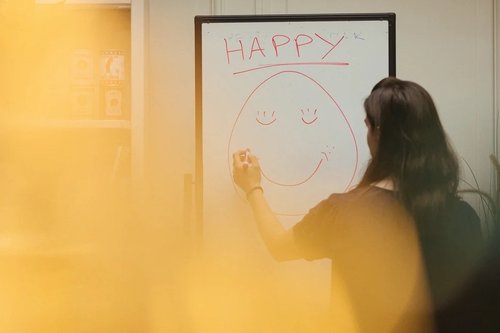Is there a way to juggle tasks without burning out?
23 févr. 2023
5min

Today’s to-do list: catch up on emails, reply on this Slack channel and then that one, check company social media, and attend two — no wait, three(!) — meetings…
Endless to-do lists often composed of unrelated tasks are a familiar reality to most professionals, and so is the feeling of scatter-brained chaos after a week in the office or in front of our screens. To boot, digitization and remote work have brought a litany of communication and organizational tools that today seem as numerous as the tasks they’re meant to facilitate. In fact, a 2021 report by project management platform Quatalog in collaboration with researchers from Cornell University shows that 43% of people feel they spend too much time switching between various online tools. Of the 1,000 UK and US-based remote workers surveyed, 45% say this makes them less productive.
So at a time when ever-increasing burnout rates show no sign of slowing down, how do we make sure our brains can keep up with it all? We asked our expert in The Lab, Albert Moukheiber, how to best manage task-switching at work.
Knowing your brain and its capacities
Is the brain capable of constantly jumping from one task to another? According to Moukheiber, a doctor in cognitive neuroscience and a clinical psychologist, there’s no doubt about it. “Human function requires the ability to switch from one task to another, so we are quite capable of that. The brain doesn’t distinguish between professional and personal, but at work, this means disengaging from an assignment, switching [mind-sets], and engaging in a new one,” he says. “This has a cognitive cost though because if we’re talking about 20-minute tasks, we lose a bit of attention and efficiency each time.”
It’s advisable to take regular breaks when carrying out a productive task. “Some people can remain attentive for an entire meeting, while others lose focus after 15 minutes. In general, it’s recommended to take a five-minute break at the end of an hour so as not to tire the brain too much,” Moukheiber says. This pause is particularly important when changing activity or direction, which leads to a loss of efficiency and mental fatigue. A break allows us to extract ourselves from the previous task and take a moment before focusing again on another.
How to switch efficiently
People who juggle different activities are called “slashers,” and they can offer some inspiration in our quest to save ourselves from burnout. Not only do they switch between tasks, but also between jobs. Marielle Barbe, a French trainer, speaker, and author of Profession Slasheur [Profession Slasher] (Marabout, 2017), shares her organizational secrets for avoiding burnout.
Get organized
To keep track of the progress for each of her tasks, Barbe recommends the to-do list, an indispensable tool in her slasher methodology. “In the same way that a lawyer will manage 20 different client files and know where he is on each one, I update folders and to-do lists. The to-do list lets us know what we need to do each day, and the folders let us know where we left off on each assignment,” she says. Listing, organizing, and taking notes allow us to know exactly where to start when switching between two tasks. “Back when I thought my brain could absorb everything, it was actually playing tricks on me. Now if I don’t have my to-do list, I’m lost.”
Create time blocks
It’s also possible to approach our day in a time-oriented manner, by grouping related tasks in the same time block. With this method, only a certain type of activity is carried out during a given period of time so there’s less of a whiplash when switching between tasks. “Scheduling your day like this isn’t always easy because you have to deal with unexpected events and last-minute requests, but combining related tasks can be a way to stay on track,” Barbe advises. This could be a morning dedicated to appointments or phone calls and an afternoon devoted to creative projects or a few hours spent on communication-related tasks.
Space stuff out
Like the 52/17 rule, which recommends alternating between 52-minute sessions of intense work and 17-minute breaks for greater efficiency, doing a different activity between two tasks is a way to completely disengage from the first task in order to start again with a fresh perspective. Depending on the amount of time invested in full concentration, the break can last more or less time which provides an opportunity to take your mind off things. “You can do anything as long as the activity is not directed toward the task,” says Moukheiber. “You can go outside, watch a video, or reply to an email. The idea is to intentionally disengage by thinking [about something else].”
Barbe found her go-to outlet for this: brisk walking. “I get a lot of ideas from walking and it has become a new slash in my day. I have to go for a walk for at least half an hour a day to relax and generate new ideas,” she says. Making a phone call, grabbing a snack, meditating, or taking time to drink coffee are all simple actions that allow the brain to disconnect so it can move on to the next activity.
Testing different methodologies
The methodology is specific to each person, so it’s good to try different strategies to find the one that suits you best. Sonia Valente author of Comment Trouver sa Place Quand On ne Fitre Dans Aucune Case [How to Find Your Place When You Don’t Fit in a Box] (Eyrolles, 2021) has experimented with several methods. As an author and certified career coach, she combined her work activities into half-days, switched between tasks every two hours, and let her clients choose their own appointment times, and this shaped her week. “However, this didn’t work because clients chose slots in the middle of the afternoon and after that my day was ruined; it was impossible to get anything else done. What worked best was to spend two or three days on a certain task before moving on to another,” she says.
Ultimately, Valente never settled on a fixed methodology. “At first, I was desperate for a rhythm and for it to stay the same, but I realized rhythms come and go,” she says. “My style of working really fluctuates depending on the time of year, my motivation, my menstrual cycle, and the topics I’m writing about. I adapt my way of working to what I find relevant at the time in order to stay productive.”
Release the pressure
Seeing things pile up on our to-do lists can make us feel overwhelmed and panicked. For Barbe though, it’s better to settle down and take a breath before jumping in. “Whether you’re a slasher or not, you can have quiet times that are counterbalanced by more intense periods,” she says. “In these cases, you have to release the pressure, prioritize your tasks, and don’t forget that life also takes care of itself. One assignment will be canceled, another will be postponed, and if you can’t get everything done, you can also ask for help.”
If you’re afraid of being overwhelmed, a look at the past may reassure you. During other intense seasons, did you manage to deliver on time? Have you ever failed your co-workers or your manager before? Were you able to find a solution? Past experiences are valuable indicators of our ability to manage and our skill in doing so.
Multi-tasking has become an essential part of our working methods and has the benefit of breaking the monotony, but to get the most out of these moments of change and avoid mental fatigue and inefficiency, a few habits can make a difference. Take breaks, clear your head between tasks, organize your day according to the nature of your assignments, and, most importantly, find your own way of working. Just as changing the layout of your furniture can be fun, changing your methodology can be a modus operandi in itself.
Check out more content related to Mental Health Awareness Month 2023 here.
Translated by Lorraine Posthuma
Photo: Welcome to the Jungle
Follow Welcome to the Jungle on Facebook, LinkedIn, and Instagram, and subscribe to our newsletter to get our latest articles every day!

Inspirez-vous davantage sur : Notre relation au travail

Advice for people pleasers: Breaking free from being “too nice” at work
Do you often say things like, "Yeah, sure, I can do that!" when in fact you don't have the bandwidth to do that? We've got you.
12 déc. 2024

There’s no place like home: Does relocation hurt productivity?
Relocating often brings homesickness, but it’s part of the journey. Here’s how to embrace the change and make the most of it.
22 oct. 2024

Should you take your office crush to the next level?
Is an office crush worth the risk, or more damaging to your career and reputation than you think?
09 oct. 2024

Young workers on unpaid internships: Was it worth it?
While internships build skills and connections, unpaid ones can limit opportunities for those who can't work for free. Is it fair?
12 sept. 2024

Sleeping less to succeed more: Do CEOs sleep as little as we think?
In today's fast-paced corporate world, a common belief is that successful leaders, particularly CEOs, need less sleep to achieve their goals.
26 août 2024
La newsletter qui fait le taf
Envie de ne louper aucun de nos articles ? Une fois par semaine, des histoires, des jobs et des conseils dans votre boite mail.

Vous êtes à la recherche d’une nouvelle opportunité ?
Plus de 200 000 candidats ont trouvé un emploi sur Welcome to the Jungle.
Explorer les jobs


